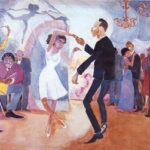Lorraine Hansberry’s play “A Raisin in the Sun” was far ahead of its time in both depicting the everyday life of black people in a way that everyone can understand and discuss the oppression that black people still felt even though strides had been taken towards civil rights. According to NPR, Hansberry shared the aims for this play with her husband. “Hansberry told her husband she wanted to write a social drama about blacks that was good art. Instead of stereotyped characters that would bear no resemblance to actual people, she invented a situation that was sometimes painfully realistic. The plot revolves around what her characters do given the opportunity to escape their cramped surroundings” (NPR). Much of the material from this play is based on Hansberry’s own life experiences.
They are real characters. The reader can feel Mama’s love for her family and her desire for them to better themselves. Travis should not have to sleep on the couch. Beneatha should be able to be a doctor, but she must be careful not to overspeak according to Mama. Beneatha’s frustration with the “outdated” ideas of her mother and her brother’s traditional marriage are felt. She is a dreamer and yet the reader wants to believe with her. Walter’s anger is perfectly justified although it gets him nowhere, and Ruth’s increasing frustration with her husband is also justified, especially as they are about to bring another child into the world. The reader hopes that Walter’s scheme will work even though he/she knows it never will. In the end, the family triumphs against daunting odds. They will have to work harder than they ever have to keep their house, and they will never fit into their neighborhood. They will likely face acts of discrimination even more pronounced, but they do not swallow their pride and submit to the demands of Lindner and their neighborhood. Her characters even speak in the dialect of a real Chicago neighborhood. She uses a non-standard dialect that would only be spoken in black communities.
The use of the poem of Langston Hughes called “Dream Deferred” makes the subject and characters even more real. It asks the reader to think about what would happen if someone worked all their lives for a dream and was unable to achieve it. The poem then gives options that fit various people within the play.
Anyone who reads the play can definitely see the struggles of African Americans. Hansberry was deeply committed to the fight for civil rights just as her parents had been. The struggles of the Younger family parallel the struggles of African Americans in a time where the discrimination was just beginning to be faced. According to Books and Writers, in 1959 Hansberry had said in a speech: “The unmistakable roots of the universal solidarity of the colored peoples of the world are no longer “predictable” as they were in my father’s time – they are here. And I for one, as a black woman in the United States in the mid-Twentieth Century, feel that I am more typical of the present temperament of my people than not, when I say that I cannot allow the devious purposes of white supremacy to lead me to any conclusion other than what may be to most robust and important one of our time: that the ultimate destiny and aspirations of the African peoples and twenty million American Negroes are inextricably and magnificently bound up together forever.” (Books and Writers). This sums up Hansberry’s ideas about the race and shows us how the play deals with the supremacy of whites. It is clear that the white characters like Karl Lindner and Walter’s boss are better off. Even the blacks who sell out in one way or another like George Murchison or Willy Harris are in better places than the Youngers. This family finds it almost impossible to get ahead as the whole social structure is opposed to them.
And while this is a play about the American Negro, it is also one with a universal theme. It is also about the failure of the American Dream, which anyone in any time period can relate to. Writing in Commentary, Gerald Weales pointed out that “Walter Lee’s difficulty … is that he has accepted the American myth of success at its face value, that he is trapped, as Willy Loman [in Arthur Miller’s Death of a Salesman] was trapped by a false dream. In planting so indigenous an image at the center of her play, Miss Hansberry has come as close as possible to what she intended–a play about Negroes which is not simply a Negro play.” (Gale Research). In other words, she has succeeded in discussing an American Negro family, and yet, making it understandable and relatable to everyone of every race. This was no easy task. This is reiterated by Critic Harold Clurman, in the Nation, noted that “A Raisin in the Sun is authentic: it is a portrait of the aspirations, anxieties, ambitions, and contradictory pressures affecting humble Negro fold in an American big city.” (Gale Research).
Much of the historical information in this play comes from Lorraine Hansberry’s own life. She grew up on the South Side of Chicago, just like in the play. Hansberry’s parents were activists as well as intellectuals and her father was a real estate agent. He violated a covenant law and moved into a white neighborhood. Their white neighbors tried to evict them. Hansberry’s father actually won an antisegregation case that he fought with the aid of the NAACP with the Illinois Supreme Court. These events are the events on which A Raisin in the Sun was loosely based. When Lorraine was eight, her parents bought a house in a white neighborhood, where they were welcomed one night by a racist mob. Their experience of discrimination there led to a civil rights case. Her father won the case; the Supreme Court declared that the discrimination was unconstitutional. However, nothing really happened in reality as a result of winning this case. Hansberry’s family also learned about the results of fighting the system as they faced many prejudices and acts of discrimination because of their fight, such as a brick being thrown through their window. . Hansberry also worked for Freedom, a progressive black newspaper from 1950 to 1953, which is seen in the play’s emphasis on civil rights (PAL). Also according to PAL, “In 1963 Lorraine Hansberry became very active in the civil rights movement in the South. She was a field organizer for CORE” (PAL). Again, her emphasis on civil rights in the play comes out of her own beliefs and actions.
In the play the topic is covered very thoroughly as the Younger family buys a house in a white neighborhood. Houses in black neighborhoods were double the price, and their dream is to get out of the run-down apartment. In discussing this, Hansberry outlines the discrimination built into housing in Chicago and other urban areas. So, they bought the house in the white neighborhood and are elated, but their elation is short-lived because Mr. Lindner shows up. The family fights back as he tries to talk them out of moving by saying things like, “I want you to believe me when I tell you that race prejudice simply doesn’t enter into it. It is a matter of the people of Clybourne Park believing, rightly or wrongly, as I say, that for the happiness of all concerned that our Negro families are happier when they live in their own communities” (Hansberry 2.3.65). He ends with a statement about Linder hoping the family knows what they are getting themselves into. In the end, even after Walter loses the money, the family decides to move anyway. They will take extra jobs to make sure that their children have a better life.
Hansberry’s interest in Africa began at an early age. According to Books and Writers, in an unfinished, partly autobiographical novel Hansberry wrote: “In her emotions she was sprung from the Southern Zulu and the Central Pygmy, the Eastern Watusi and the treacherous slave-trading Western Ashanti themselves. She was Kikuyu and Masai, ancient cousins of hers had made the exquisite forged sculpture at Benin, while surely even more ancient relatives sat upon the throne at Abu Simbel watching over the Nile…” (Book and Writers). This love of and interest in Africa is shown through both Asagai and Beneatha. Beneatha and Asagai show this interest in African pride in a time in America that was well before Africans began taking interest in their roots or going back to Africa. Asagai is from Africa and has great pride in it; Beneatha is interested in her roots even though she does things like straighten her hair, which Asagai says is assimilationist. Asagai even woos her with his pride in his country. For example, “I will show you our mountains and our stars; and give you cool drinks from gourds, and teach you the old songs and the ways of our people” (Hansberry 3.1.55). While Walter makes fun of all the African conversation, that is also historically accurate ahead of its time. Many Africans were interested in their past and wanted to learn about their terrible past. Some, such as Malcolm X, even went so far as to change their name to reflect their former slave status. Others thought the interest was dumb, a part of their past, not their future.
Lorraine Hansberry also puts Beneatha forth as a feminist long before women began demanding their rights. The National Organization for Women was not formed until the late 1960s. Yet Beneatha is a feminist. When Asagai makes the statement, “For a woman it should be enough”, Beneatha replies, “I know-because that’s what it says in all the novels that men write. But it isn’t. Go ahead and laugh-but I’m not interested in being someone’s little episode in America” (Hansberry 1.2.114). She wants to be a doctor, and her conviction is so strong that the reader believes her. Hansberry was also a feminist ahead of her time to put these ideas into writing. Even though Beneatha seems to “flit” from one thing to another, she is in the process of finding her identity. Exploring options and experiencing life is the way that she will find herself as well as having diverse friends like Joseph Asagai. Even her name implies that she believes everything is beneath her. Sometimes irritating, Beneatha is a true feminist before her time. Feminist as anything else is a progression in coming into womanhood. For example, Mama speaks matter-of-factly of her husband’s womanizing ways. She does not condemn him, but seems to accept that womanizing is what men do. Ruth would not put up with that from Walter although she does defer to him on a number of occasions. She also has a more gentle way of getting him to come around. Beneatha represents the “new woman” or feminist in that she would not put up with any of this. She wants to forge her own identity independent of a man. She believes that people must accept her as she is and refused to “be nice” as Mama tells her.
This play also shows the change in black arts and intellectualism. According to Schmoop, “A Raisin in the Sun is part of broader shift in black art towards depicting working-class, ordinary African-Africans. Previously, black intellectuals did not use literature, art, or the stage to portray working-class African-Americans for fear they would perpetuate undesirable stereotypes.” (Schmoop). Lorraine Hansberry and Langston Hughes both thought this idea ridiculous. They, in fact, felt the opposite. They felt that they could challenge these stereotypes by writing about them. Also according to Schmoop, “By focusing on the dreams and aspirations of one particular working-class black family, moreover, Hansberry was able to show audiences the universality of black aspirations while also demonstrating that their race posed a significant barrier to achieving those goals” (Schmoop). That is precisely what Hansberry did. She showed the trials and struggles of one family. The family is black, and some of the themes only those of color could relate to but others are universal-family love, sibling rivalry, wanting the best for children, wanting to make money and have more, etc.
A Raisin in the Sun is a masterful play. While some see it overly simplistic, Hansberry gives us the gamut of African American response to the oppression that was still occurring. Walter is just angry. Mama and Ruth are more concerned with just getting by and providing better opportunities for the next generation. Willy Harris steals from his own to get ahead, and George Murchison rejects his own upbringing. Asagai also rejects American ways, but he is African. Beneatha most represents Lorraine Hansberry as she tries to fight the system, fight society’s expectations of her as a black woman, and forge her own identity. All emotions are represented in this play.
Works Cited
Books and Writers. http://www.kirjasto.sci.fi/corhans.htm
http://www.shmoop.com/intro/literature/lorraine-hansberry/a-raisin-in-the-sun.html
Colas, Brandon. Lorraine Hansberry. A Raisin in the Sun. The Ghetto Trap. Retrieved
November 28, 2008 at http://www.literature-study-online.com/essays/hansberry.html
Corley, Cheryl. A Raisin in the Sun. March 11. 2002. NPR. Retrieved November 26,
2008 at http://www.npr.org/programs/morning/features/patc/raisin/
Hansberry, Lorraine. A Raisin in the Sun.
Lorraine Hansberry.” Authors and Artists for Young Adults. Vol. 25. Gale Research,
1998. Reproduced in Biography Resource Center. Farmington Hills, Mich.:
Thomson Gale. 2007. http://www.edupaperback.org/showauth.cfm?authid=93
Reuben, Paul. PAL: Perspectives in American Literature. Retrieved November 27, 2008
at http://www.csustan.edu/English/reuben/pal/chap8/hansberry.html





